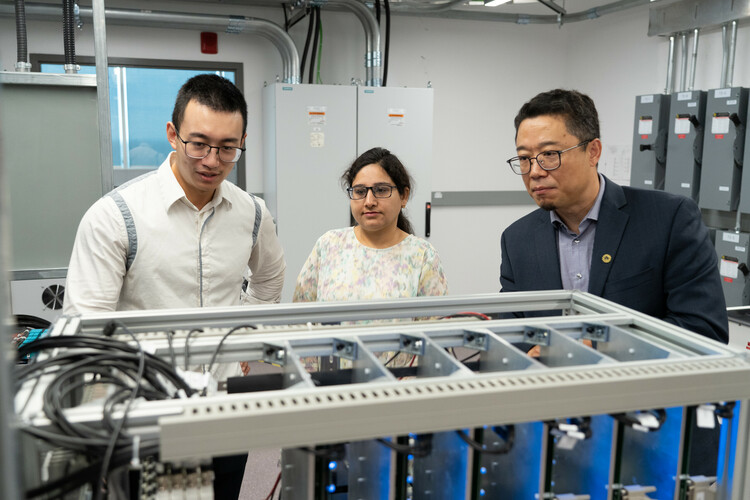The Project Report: Transforming Alberta’s Grid for Tomorrow’s Energy Demand
Posted on
Dr. Ryan Li (right) with members of his research team in the ELITE Grid Research Lab
In January 2024, Alberta experienced a two-week-long cold snap, during which the provincial electrical grid faced extreme stress due to a higher-than-normal energy demand. The province issued an emergency alert asking Albertans to immediately conserve energy where they could to alleviate the grid stress.
Electrical system resilience has become central to energy security for an increasing global demand. At the University of Alberta’s Department of Electrical and Computer Engineering, Dr. Ryan Li and the ELITE Grid Research Lab are improving Alberta’s electrical grid infrastructure to ensure the province continues to meet energy demands for a growing population and technological changes. It's no longer just about keeping the lights on; it's about building a smarter, more adaptable grid in a world that’s becoming more digitized by the day.
Alberta’s electrical grid
Alberta’s electrical grid was first built in Calgary during the early 20th century, with its primary functions intended to support communities. Today, the grid is divided into three parts: power generation, transmission, and distribution. As grid researchers, Ryan and his team of computer and electrical experts work with infrastructure across all three branches.
The 21st century has seen a global shift toward cleaner, renewable energy resources. Even in a fossil fuel-dominated energy economy like Alberta, recent years have seen a shift toward diversified energy resources, such as hydrogen, solar, and wind energy. But new energy resources mean understanding new challenges.
One example is the type of current running through the grid. Around 100 years ago, Alberta’s grid was established to run on alternating current (AC), meaning electrons flow in alternating directions. Today, energy storage technologies and renewable energy resources generate a direct current (DC), meaning electrons all flow in the same direction, and converters are needed for integration. Another challenge with different energy sources is the consistency of generated power, or electrical load, entering the grid system.
“We design AC/DC converter devices, but we also design ways to control them,” Ryan explains. “Since many DC sources, such as solar power, offer intermittent energy at varied amounts, we need a way to stabilize the flow of energy into the larger grid.”
Smarter grids for a growing demand
As Alberta’s population grows and energy demand increases with technologies like electric vehicles and data centres, the need for a smarter, more resilient grid becomes urgent.
“Overall energy demand is increasing every year in Alberta,” Ryan says. “Other than a growing population, there are more electric vehicles on the roads, which are contributing to mass consumption.”
Ryan and his lab also factor in backup generation or energy storage technologies to meet energy demands. During the harsher periods of Alberta’s cold winters, for example, freezing temperatures can prevent certain methods of energy generation.
“Alberta’s winters can get very cold, sometimes to the point that it’s too cold for wind turbines or we’re using more energy than usual,” Ryan describes. “In these cases, we have to rely on traditional energy generation methods or energy storage technologies to meet the increased demand.”
To help address these challenges, Ryan and the ELITE Grid lab have developed smart grids that can support high-efficiency renewable energy generation, manage their intermittent electrical loads, and integrate them into the larger grid. Smart grids leverage sophisticated algorithms to predict usage patterns, prevent overloads, and ensure that energy is delivered where and when it’s needed.
“Prosumer—a blended word for producer and consumer—grids are a type of smart grid we’ve been working with,” Ryan shares. “These smart grids give consumers the ability to send energy back to the grid, sometimes even at a profit. So an example could be an electric vehicle owner sending power from their EV battery back to the grid to power their own home during a blackout.”
The energy flows from the grid to the consumer, but also allows the consumer to become an energy producer. Essentially, smart grid technologies allow the prosumer grids to support bidirectional charging, meaning energy can flow both from the grid and back to it from the EV charger.
Building Resilience, One Innovation at a Time
Looking ahead, the ELITE Grid Lab is focusing on renewable grid integration and smart grids, but also on making the system more efficient overall. More recently, that includes helping large energy users—like data centres—minimize their consumption through better infrastructure design and energy-efficient operation.
“AI is a topic that everyone is discussing nowadays,” Ryan says. “We’re looking at how to power data centres more efficiently so they draw less power from Alberta’s grid. This might include being powered by microgrids or energy storage solutions and ensuring that the centres can generate as much energy as they use.”
Thanks to the ongoing efforts of Dr. Ryan Li and the ELITE Grid Research Lab, Alberta’s grid is on its way to being more resilient, responsive, and ready for the future.
Further Reading:
Distributed Energy Resources Management for Grid Modernization and Grid Transformation Applications
History of the electricity industry - AUC
Home - ELITE Grid Research Lab